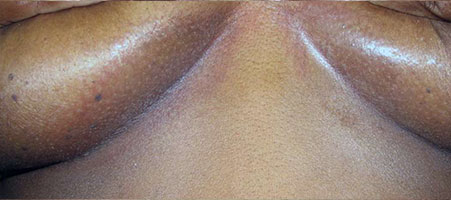Breast Case Studies
These studies were designed to determine the efficacy of InterDry® used in place of the standard treatments.
Breast Case Study 17
Patient description: 53-year-old female with morbid obesity (BMI 62.8), angina, pulmonary embolism, venous insufficiency and bipolar disorder.
Past treatments: Cleansing with a body wash followed by a lotion and an antifungal powder two times a day and as needed.
InterDry® protocol: Cleanse the skin with Bedside-Care® Foam. Place InterDry in the skin fold. Reposition as needed. Replace if soiled. Discard on day five (5).

Day 1
Intertrigo under the left breast, which has been present for twelve (12) weeks. Symptoms included severe erythema, denudement, maceration, satellite lesions, odor and complaints of itching/burning.

Outcome: Day 5
Complete resolution of denudement, maceration, satellite lesions, and odor. Slight erythema with dry flaking skin remains. No further complaints of itching/burning.
Breast Case Study 26
Patient description: 92-year-old female patient presented for care of venous stasis ulceration.
Past treatments: Prescription antifungal powder applied twice daily and an oral antifungal administered daily for five days. The rash persisted and she was then treated with an antifungal cream applied two times daily for two weeks. Treatments were not effective.
InterDry protocol: Two strips of InterDry® under each breast using a cotton sports bra to keep fabric in place.

Day 1
Persistent, painful rash underneath her breasts. Candidal intertrigo with erythematous papules, satellite lesions, denudement, weeping and a musty odor.

Outcome: Week 3
Patient followed up weekly with improvement noted at week 2 and resolution of symptoms and rash by week 3.
Breast Case Study 39
Patient description: 39-year-old female presented with grade II lymphedema of the right arm.
Past treatment: Over the counter antifungal powder.
InterDry protocol: Apply the silver coated textile over the affected area and leave it in place. She was allowed to remove the fabric for the duration of her shower.

Day 1
Patient complained of intense pruritus and burning under both breasts.

Outcome: Day 7
Skin dry but still with significant erythema present. No more pruritus or burning.
Breast Case Study 410
Patient description: 66-year-old, 425 lbs. (193 kg) male with congestive heart failure (CHF), a history of COPD, obstructed sleep apnea, chronic left leg ulcer and morbid obesity.
Past treatments: Patient had unsuccessfully tried to treat the area with creams that he found difficult to apply, expensive and were minimally effective in reducing his symptoms.
InterDry protocol: Moisture-wicking fabric with silver was applied on Day 1 by the WOC nurse with goals focused toward wicking excess moisture, reducing inflammation and in turn, reducing pain, itching, erythema, and eliminating odor-causing microorganisms.

Day 1
Erythema at the patient’s chest skin fold. Extreme pain, itching and odor.

Outcome: Day 7
Almost complete elimination of symptoms. Reduced signs of inflammation, discomfort and odor.
